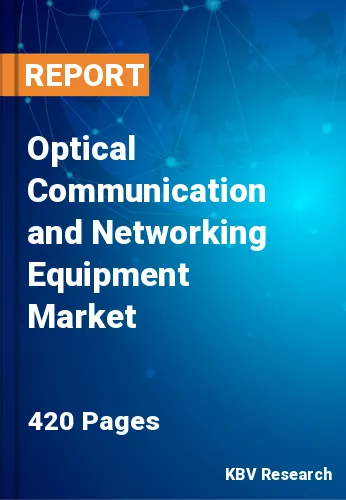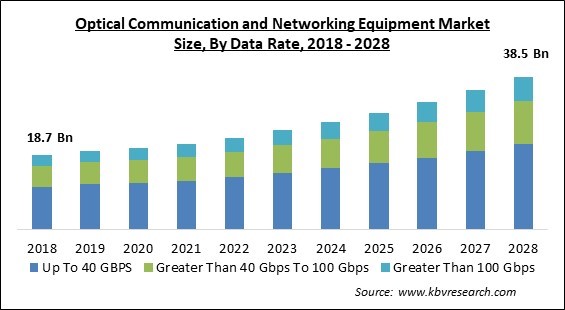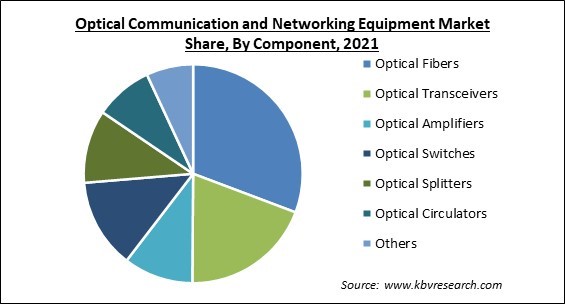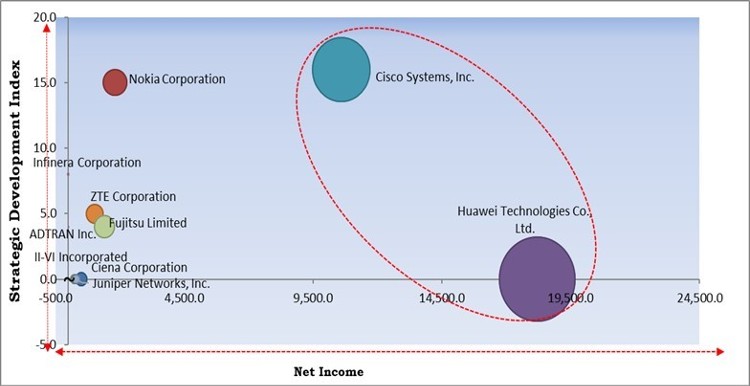
The Global Optical Communication and Networking Equipment Market size is expected to reach $38.5 billion by 2028, rising at a market growth of 8.8% CAGR during the forecast period.
Optical communication and networking equipment use light to send signals that are encoded with information in different kinds of telecommunications networks. It involves a limited range of local-area networks (LAN) or wide-area networks (WAN), that cross metropolitan & regional areas along with long-distance national, international & transoceanic networks. Optical amplifiers, transceivers, termination devices, tunable filters, and add-drop multiplexers are among the optical components used in optical communication and networking. The market for optical communication and networking equipment is expanding as a result of the development of telecommunications infrastructure in developing nations.

The market is growing as a result of factors such as the increase in data traffic brought on by increased internet usage, the growing number of data centers, and the rising popularity of cloud-based and virtualization services. On the other hand, it is anticipated that the rapid implementation of VOIP, LTE, and 5G networks would offer attractive potential for market expansion. Additionally, the industry for optical communication and networking equipment is predicted to benefit from the surge in usage of AI and IoT.
The large bandwidth and scale needs of modern data center networks have led to the use of optical communication and networking technology. Over large distances, only optical communication technology has exhibited a capacity of 10 GB/s, 40 GB/s, and higher. In order to provide essential communications connectivity among various servers, computing resources, and memory, a rising number of data centers throughout the world rely on interconnects. In addition, factors including the rapid expansion of Internet Protocol (IP) traffic and cloud computing are boosting the number of data centers globally. As a result, the market for optical communication and networking equipment is growing rapidly due to the development of data centers.
The COVID-19 pandemic has had a substantial impact on the market for optical communication & networking equipment. Many firms first had supply issues as a result of production interruptions, which was the principal effect of the outbreak. The need for residential, commercial, and industry use of automation systems of buildings has declined as a result of lockdown measures and the suspension of non-essential companies. As a result, the production & supply of networking and optical communication equipment is returning to normal.
As more devices are connected to the internet and new applications are created, the volume of information that is being transmitted through it, is continuously increasing. Mobile data traffic is also predicted to expand exponentially. Furthermore, it is expected that an increase in smartphone users will increase internet usage. There is an increased attention of the companies on meeting the surge in demand for telecommunications equipment brought on by the quickening of 5G deployment across the globe.

The expansion of the market would be positively impacted by the development of the telecommunications infrastructure in developed economies. The introduction of AI (artificial intelligence), and big data, along with the IoT (internet of things) has raised the need for smart gadgets and other associated applications. The telecommunications industry relies on interconnected technologies to move, capture, and translate data into useful information that is essential for bolstering urban infrastructure.
The use of connection ICs is expanding as a result of the diversity of protocols and platforms available, as well as the consistent need for smaller networks. Besides this, both hardware and software are essential components of products based on advancing technology, like IoT (Internet of Things) devices that are used in optical communication systems. The network is becoming by the usage of ICs and IoT devices. Similar to this, a single small device must be fixed with variable optical attenuators, drop modules, as well as tap power monitors for network monitoring and control.
On the basis of components, the Optical Communication and Networking Equipment Market is segmented into optical fibers (single-mode fibers, multi-mode fibers), optical transceivers, optical amplifiers, optical switches, optical splitters, optical circulators and others. Optical splitter segment procured a promising revenue share in 2021. An optical splitter or beam splitter is an incorporated waveguide optical power distribution device that has multiple input and output ends that can split an incident light beam into two or more light beams or vice versa.
Based on vertical, the optical communication & networking equipment market is divided into BFSI; government, military & defense; healthcare; IT & Telecom; and energy & utilities and others. In 2021, the healthcare segment acquired a promising revenue share in the optical communication & networking equipment market. This is because an efficient optical fiber network makes sure that medical institutes can transfer healthcare data in an efficient and secure manner. Also, it opens more ways of communication between the patients and healthcare providers.
Based on technology, the optical communication & networking equipment market is divided into SONET/SDH, Wavelength Division Multiplexing (WDM), and fiber channels. In 2021, the WDM segment generated the maximum revenue share in the optical communication & networking equipment market. WDM (Wavelength Division Multiplex) is a technique that allows the utilization of multiple light wavelengths in order to data through the same medium. The major factor responsible for the market growth in this segment is the fact that WDM technology increases bandwidth by enabling various data streams with different frequencies.
By data rate, the optical communication & networking equipment market is classified into up to 40 GBPS, greater than 40 Gbps to 100 Gbps, and greater than 100 Gbps. The greater than 100Gbps segment covered a significant revenue share of the optical communication & networking market. The demand for larger bandwidth devices with a data rate of greater than 100 Gbps is expected to grow in upcoming years because of the continuous development of 5G & high-performance services brought by cloud networks.
On the basis of application, the optical communication & networking equipment market is fragmented into Telecom, data center, and enterprises. Telecom segment procured a revenue share in the optical communication and networking market in 2021. The growing need of high-speed communication which could be fulfilled by deployment of optical fibers supporting the growth of optical communication & networking equipment market. Increasing demand of value-added managed services is another factor supporting market growth in this segment.
| Report Attribute | Details |
|---|---|
| Market size value in 2021 | USD 21.5 Billion |
| Market size forecast in 2028 | USD 38.5 Billion |
| Base Year | 2021 |
| Historical Period | 2018 to 2020 |
| Forecast Period | 2022 to 2028 |
| Revenue Growth Rate | CAGR of 8.8% from 2022 to 2028 |
| Number of Pages | 420 |
| Number of Tables | 673 |
| Report coverage | Market Trends, Revenue Estimation and Forecast, Segmentation Analysis, Regional and Country Breakdown, Competitive Landscape, Companies Strategic Developments, Company Profiling |
| Segments covered | Component, Vertical, Data Rate, Technology, Application, Region |
| Country scope | US, Canada, Mexico, Germany, UK, France, Russia, Spain, Italy, China, Japan, India, South Korea, Singapore, Malaysia, Brazil, Argentina, UAE, Saudi Arabia, South Africa, Nigeria |
| Growth Drivers |
|
| Restraints |
|
Region-wise, the oral communication & networking equipment market is analyzed in North America, Europe, Asia Pacific, and LAMEA. In 2021, North America region emerged as the leading region in the optical communication & networking equipment with the maximum revenue share. It is because this region is a significant hub for data centers and cloud computing. The United States is the biggest consumer of networking and optical communication equipment market. Additionally, the growth can be attributed to the increased application of advanced optical technologies in the region.
Free Valuable Insights: Global Optical Communication and Networking Equipment Market size to reach USD 38.5 Billion by 2028

The major strategies followed by the market participants are Partnerships. Based on the Analysis presented in the Cardinal matrix; Huawei Technologies Co., Ltd. and Cisco Systems, Inc. are the forerunners in the Optical Communication and Networking Equipment Market. Companies such as Nokia Corporation, Infinera Corporation, ZTE Corporation are some of the key innovators in Optical Communication and Networking Equipment Market.
The market research report covers the analysis of key stake holders of the market. Key companies profiled in the report include Fujitsu Limited, Cisco Systems, Inc., Huawei Technologies Co., Ltd. (Huawei Investment & Holding Co., Ltd.), Nokia Corporation, Juniper Networks, Inc., ZTE Corporation, ADTRAN, Inc., II-VI Incorporated, Ciena Corporation, and Infinera Corporation.
By Component
By Vertical
By Data Rate
By Technology
By Application
By Geography
The optical communication and networking equipment market size is projected to reach USD 38.5 billion by 2028.
Increased Internet Usage Across The World are driving the market in coming years, however, Rise In The Network Complexity limited the growth of the market.
Fujitsu Limited, Cisco Systems, Inc., Huawei Technologies Co., Ltd. (Huawei Investment & Holding Co., Ltd.), Nokia Corporation, Juniper Networks, Inc., ZTE Corporation, ADTRAN, Inc., II-VI Incorporated, Ciena Corporation, and Infinera Corporation.
The Optical Fibers segment acquired maximum revenue share in the Global Optical Communication and Networking Equipment Market by Component in 2021, achieving a market value of $10.7 billion by 2028.
The Datacenter segment is leading the Global Optical Communication and Networking Equipment Market by Application in 2021, achieving a market value of $18.7 billion by 2028.
The North America market dominated the Global Optical Communication and Networking Equipment Market by Region in 2021, and would continue to be a dominant market till 2028; thereby, achieving a market value of $12.6 billion by 2028.
Our team of dedicated experts can provide you with attractive expansion opportunities for your business.
